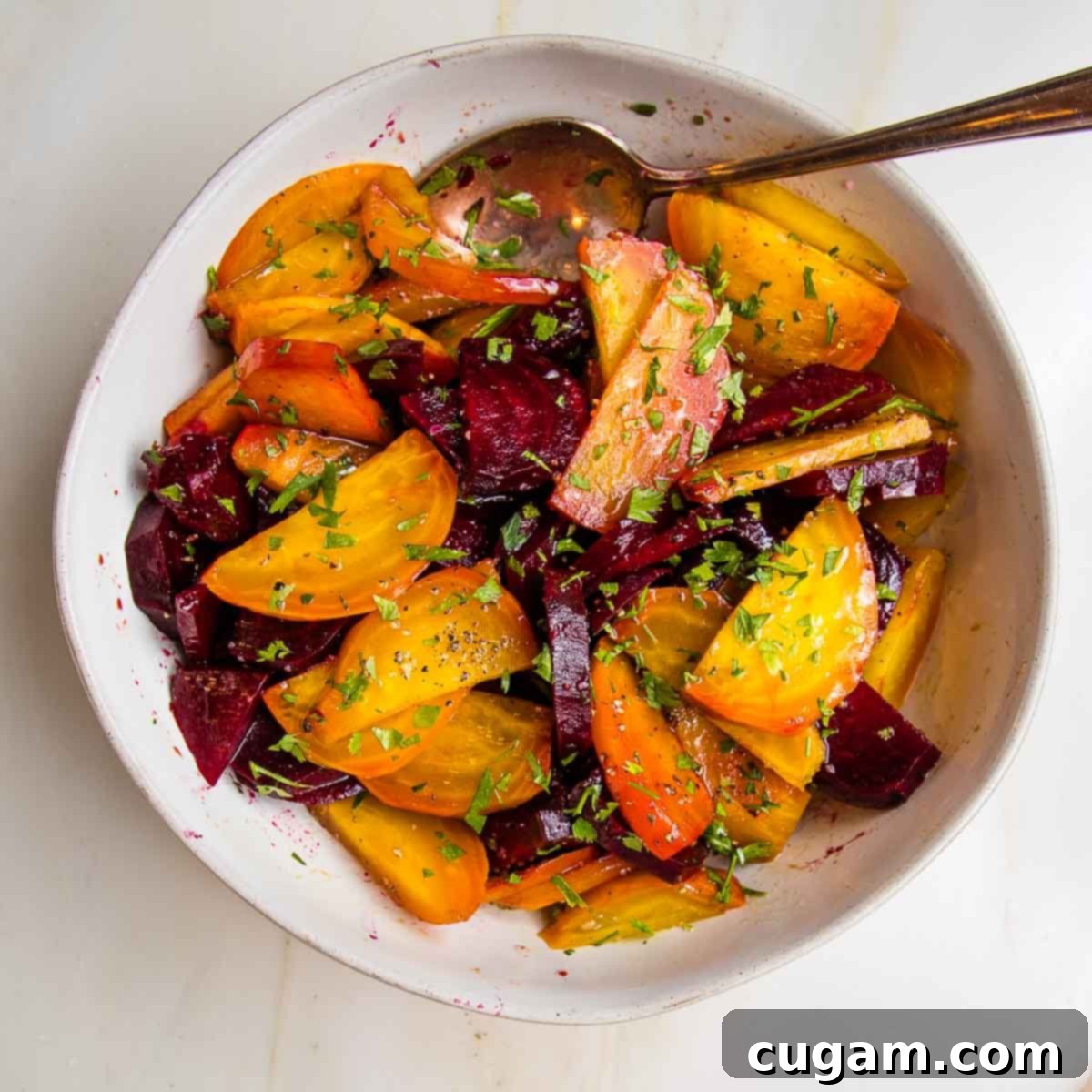Elevate Your Meal: Easy Whole Roasted Beet Salad with Tangy Balsamic Vinaigrette (Cheese-Free & Delicious!)
Are you a beet enthusiast searching for that perfect, easy-to-make beet salad recipe without cheese? Look no further! This delightful Whole Roasted Beet Salad with Balsamic Vinaigrette is more than just a simple side dish; it’s a vibrant, nutritious, and incredibly flavorful addition to any healthy meal. Its natural sweetness, coupled with the zesty kick of a homemade balsamic dressing, creates a flavor profile that will truly captivate your palate and quickly become a favorite.
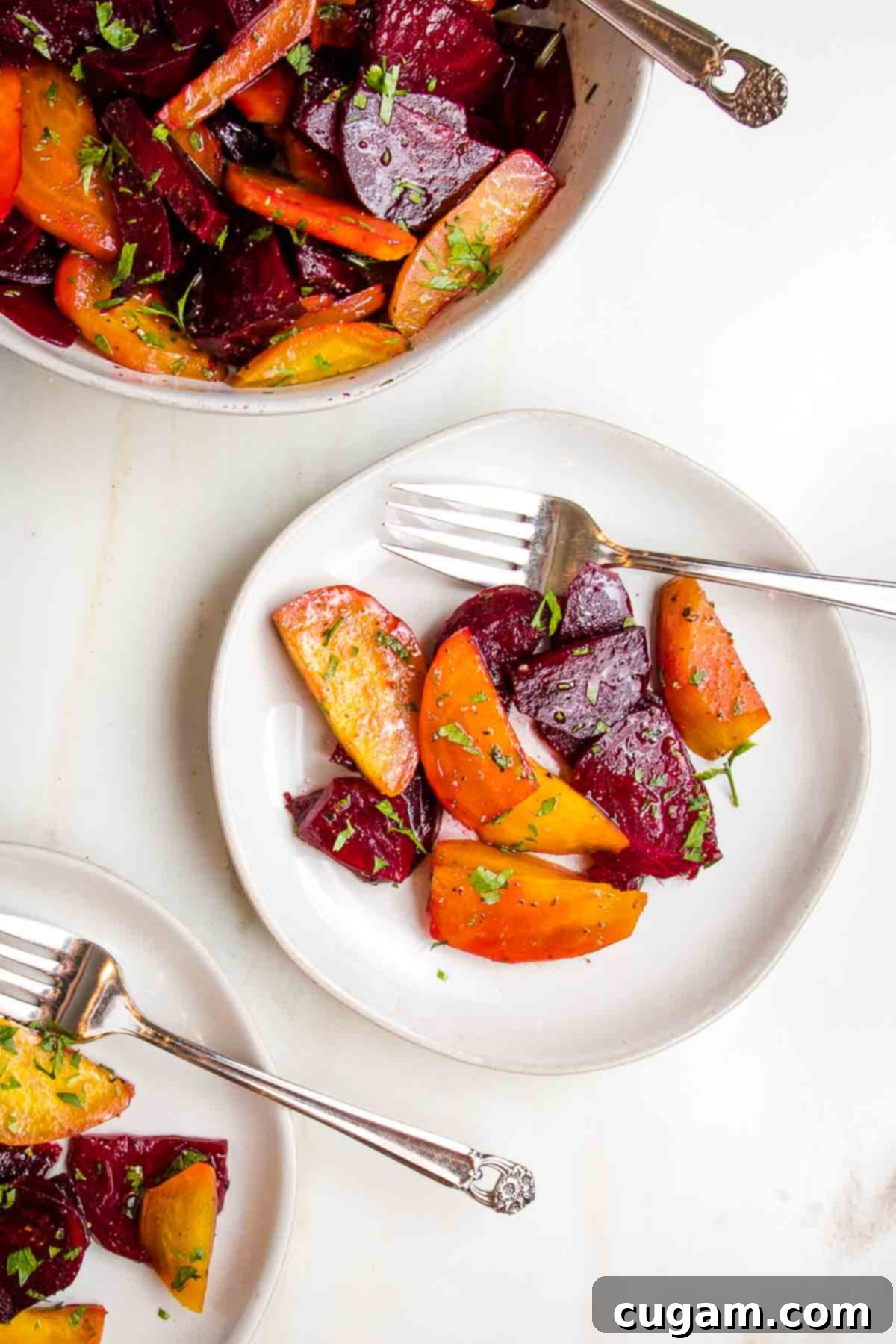
This post was updated from the original dated June 21, 2016, to bring you even more tips and details for the perfect roasted beet salad.
Roasted beet salad is not only tasty and delicious but also absolutely gorgeous, bringing a splash of color to your table. Roasting root vegetables is a fantastic way to enhance their natural sugars, transforming them into a sweet and earthy treat. Beyond salads, roasted beets can be surprisingly versatile; ever thought about adding a few to your food processor when making low-carb hummus for a stunning, naturally colored dip? The possibilities are endless when you master the art of roasting beets.
Why Roast Beets Whole? The Secret to Perfect Beets
My absolute favorite, and arguably the easiest, way to prepare beets for any recipe is to roast them whole. This method simplifies the cooking process immensely, whether you’re working with vibrant red beets or their milder golden counterparts. Forget about messy red hands from peeling raw beets or struggling with a vegetable peeler; whole roasting makes the skins effortlessly slide off once cooked. This means less prep time, less cleanup, and more enjoyment of your culinary creation.
Roasting beets whole also locks in their natural moisture, resulting in a tender, melt-in-your-mouth texture that can be hard to achieve with other cooking methods. Furthermore, this gentle heat intensifies their inherent sweetness, making them incredibly flavorful. This process also helps to preserve more of their delicate nutrients, ensuring you get the most health benefits from every bite. Once roasted and peeled, you have the freedom to cut them into any shape or size – wedges, cubes, or slices – and dress them as you wish. For a salad like this, the sweet and earthy notes of the beets, combined with the zing of a balsamic vinaigrette, create an explosion of flavor that will make any beet lover’s dream come true!
Discovering the Wonderful World of Beets: Varieties & Benefits
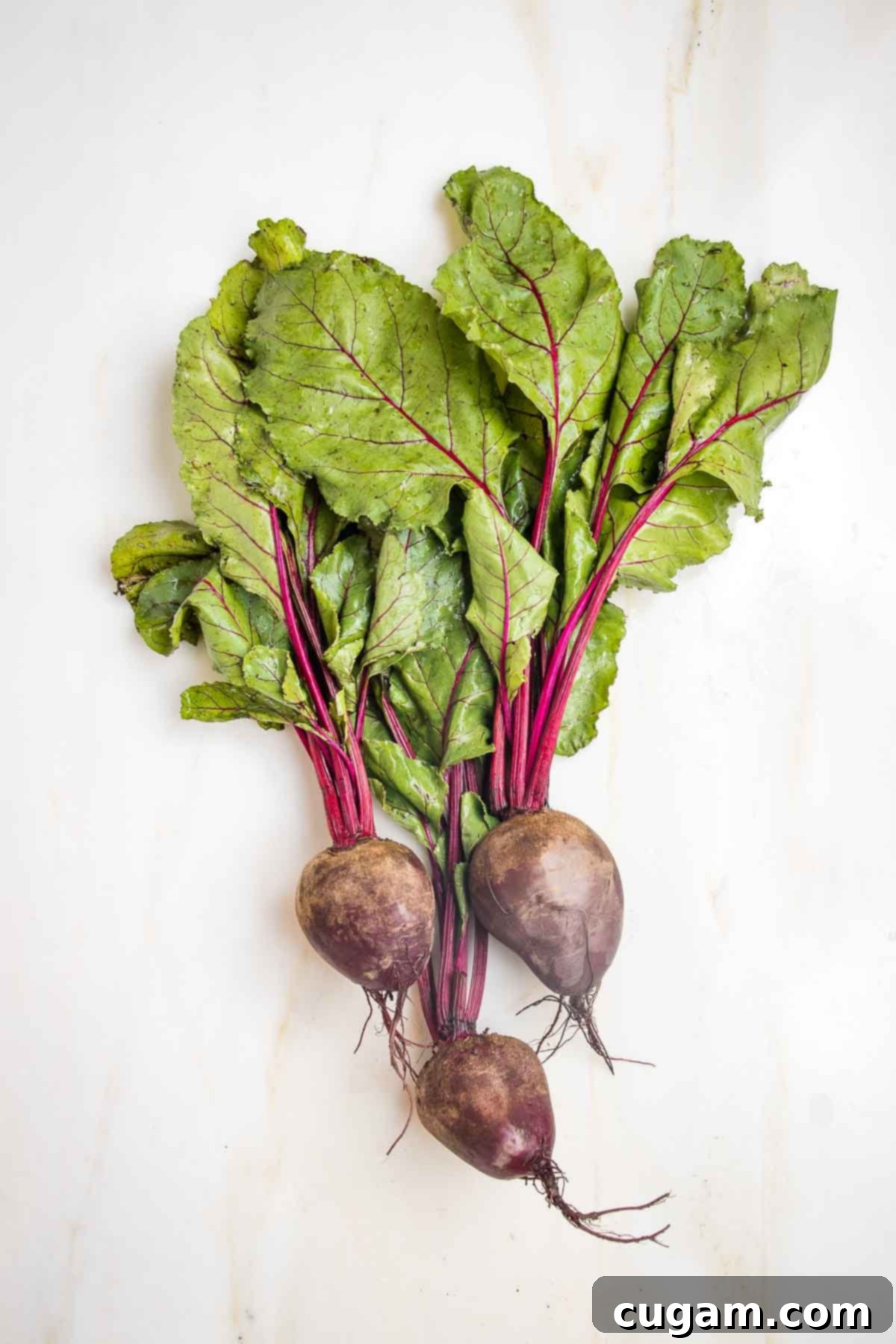
Beets are an incredibly versatile and nutritious root vegetable, offering a wealth of health benefits and culinary applications. They are rich in essential vitamins and minerals, including fiber, folate, manganese, potassium, and vitamin C, making them a fantastic addition to a balanced diet. Their distinctive earthy flavor profile is truly unique, and roasting helps to mellow any bitterness while amplifying their natural sweetness.
When selecting beets for your salad, you generally have two main choices: **red beets** and **golden beets**. Red beets are the most common, known for their deep crimson hue and classic earthy taste. They are excellent sources of powerful antioxidants called betalains, which give them their vibrant color. Golden beets, on the other hand, possess a slightly sweeter and milder flavor profile, with a beautiful golden-yellow flesh that won’t stain your hands or cutting board as readily as red beets. Using a combination of both red and golden beets in your salad not only offers a subtly varied taste experience but also creates a visually stunning dish with contrasting colors that’s sure to impress your guests.
Different Methods for Roasting Whole Beets for Maximum Flavor and Convenience
Choosing the right method for roasting your whole beets can depend on your available time, preferred texture, and the kitchen equipment you have on hand. Each method below guarantees tender, flavorful beets perfect for your salad:
- Instant Pot Beets: If you’re short on time but still crave perfectly tender beets, your pressure cooker is an absolute game-changer. It significantly reduces cooking time while ensuring your beets are uniformly cooked and wonderfully tender. This method uses steam under pressure to quickly break down the beet’s fibers, making them ideal for a fast weeknight meal. It’s a method I highly recommend for efficiency and excellent results.
- Dutch Oven Roasting: For a classic oven-roasted approach that doesn’t require aluminum foil, a Dutch oven or any other heavy, covered baking dish works beautifully. The heavy lid creates a self-basting, steamy environment, helping the beets to cook evenly and remain moist and succulent. This method yields wonderfully tender beets with a slightly caramelized exterior that adds another layer of flavor.
- Baking Dish with Foil: This is another reliable oven method that relies on steaming the beets. Choose a shallow baking dish large enough to hold all your beets in a single layer. The key here is to create a tight seal to trap the steam. I recommend wetting a piece of parchment paper, crumbling it to squeeze out excess water, then laying it directly over the beets before sealing the dish tightly with a layer of heavy-duty aluminum foil. The damp parchment helps create a perfect steaming environment and prevents the beets from drying out.
- Foil Packet Roasting: While a common method, wrapping beets directly in aluminum foil is one I approach with caution due to concerns about aluminum leaching into food. If you choose this method, I strongly advise placing a layer of parchment paper between the beets and the foil. This creates a protective barrier. To prepare, wrap individual trimmed whole beets in these foil-parchment packets and place them on a rimmed baking sheet. The foil pouch will trap hot air and steam the beets effectively, but the parchment ensures safe contact.
Essential Ingredients for Your Vibrant Beet Salad with Balsamic Vinaigrette
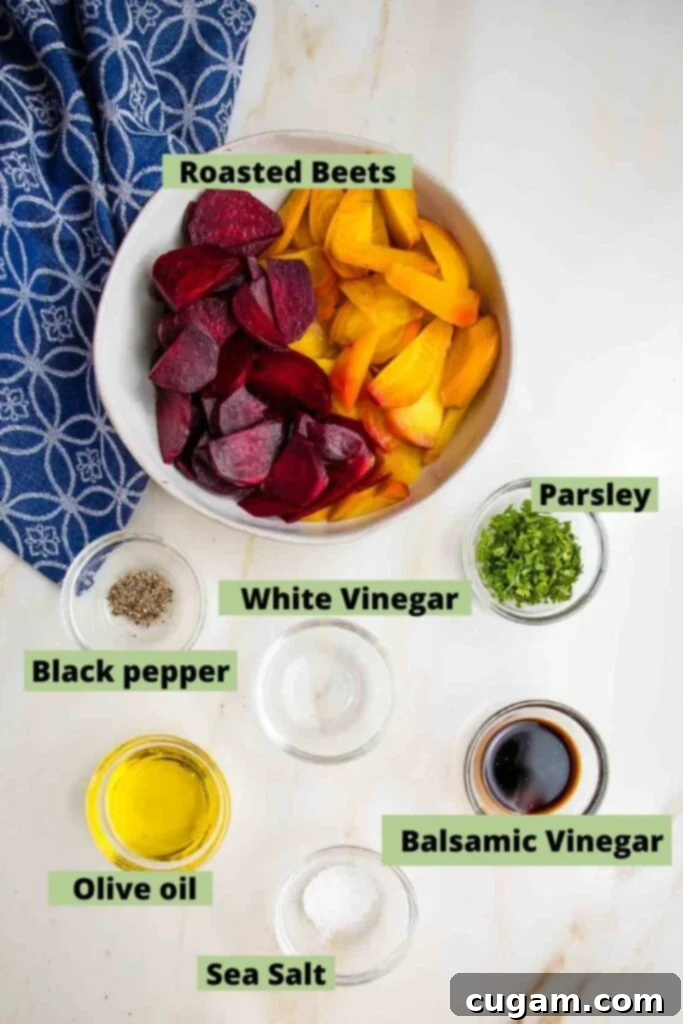
This recipe celebrates the natural flavors of its core ingredients, enhanced by a simple yet potent vinaigrette. Each component plays a crucial role in creating a balanced and utterly delicious salad:
- Beets: The undisputed star of our show! Whether you opt for entirely golden beets, all red beets, or a beautiful, colorful combination of both, the choice is yours. Roasting them whole is paramount for preserving their rich nutritional value, vibrant color, and firm yet tender texture. This method ensures you get the most out of these superfoods, which are packed with fiber, folate, and manganese. Have you ever tried whole roasted cauliflower? It’s another whole-roasting delight that brings out incredible flavors!
- Extra Virgin Olive Oil: A generous drizzle of high-quality extra virgin olive oil not only coaxes out the deep, earthy flavors of the roasted beets but also serves a vital nutritional purpose. The healthy monounsaturated fats in olive oil are essential for the better absorption of fat-soluble vitamins, such as Vitamin A (in the form of beta-carotene), which is found in abundance in beets. It also adds a silky richness to the dressing.
- Vinegar: Our vinaigrette’s backbone comes from a thoughtfully balanced blend of white vinegar and balsamic vinegar. The bright acidity of white vinegar provides a sharp contrast, while the rich, slightly sweet notes of balsamic vinegar add depth and complexity. This combination creates the perfect acidic counterpoint to the natural sweetness of the beets, resulting in a harmonious flavor profile that is both tangy and sweet. For a lighter color and a slightly fruitier flavor, you can also opt for white balsamic vinegar.
- Fresh Herbs: Fresh parsley is my preferred herb for this salad, adding a bright, peppery note along with a significant boost of potassium and vitamins A, K, and C. Its vibrant green color also offers a beautiful contrast to the deep hues of the beets, making the dish visually appealing. Feel free to experiment with other fresh herbs like basil, oregano, or thyme, depending on your personal preference and what you have on hand.
- Seasoning: Sometimes, simplicity is best. A modest sprinkle of coarse sea salt and freshly ground black pepper is all that’s truly needed to elevate this beet salad from good to absolutely incredible. These basic seasonings enhance the natural flavors of the beets and the zing of the vinaigrette without overpowering them. Always taste and adjust to your personal preference.
How to Roast Whole Beets for the Perfect Salad: A Step-by-Step Guide
Preparing beetroot for this salad is wonderfully straightforward, especially when you utilize the whole beet roasting method. This particular recipe focuses purely on the beets themselves, allowing their exquisite flavor to shine. However, it’s also fantastic tossed with fresh arugula, robust kale, or even sautéed beet greens for an added layer of flavor and texture, transforming it into a more substantial meal. If you adore beets, you might also enjoy my Roasted Squash and Beet Salad for another delightful combination of sweet and earthy flavors.
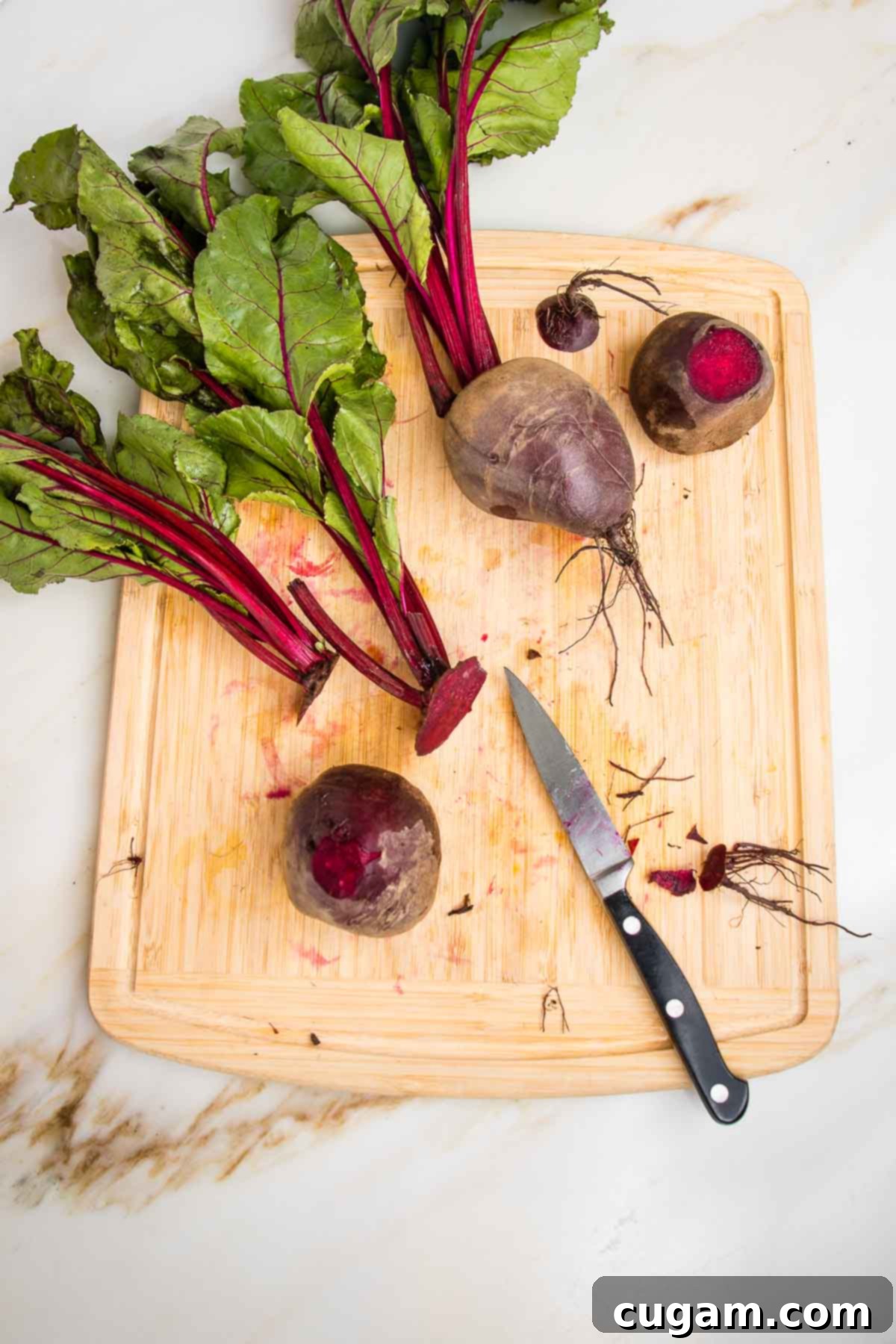
The first crucial step is to meticulously prepare your beets. To prevent the vibrant pigments from staining your hands, I highly recommend wearing a pair of kitchen gloves. This will keep your hands clean while you work with these beautiful, colorful root vegetables. You’ll thank me later!
Using a sharp paring knife, carefully trim both the beet greens and the tough stems from the top of the beets. Additionally, trim the root end just enough so that the beets can sit flat and stable during cooking. Don’t discard those nutritious greens and stems! Set them aside; they can be stored in the fridge for up to two days and used in a variety of other recipes, as detailed in my pro tips section below. Waste not, want not!
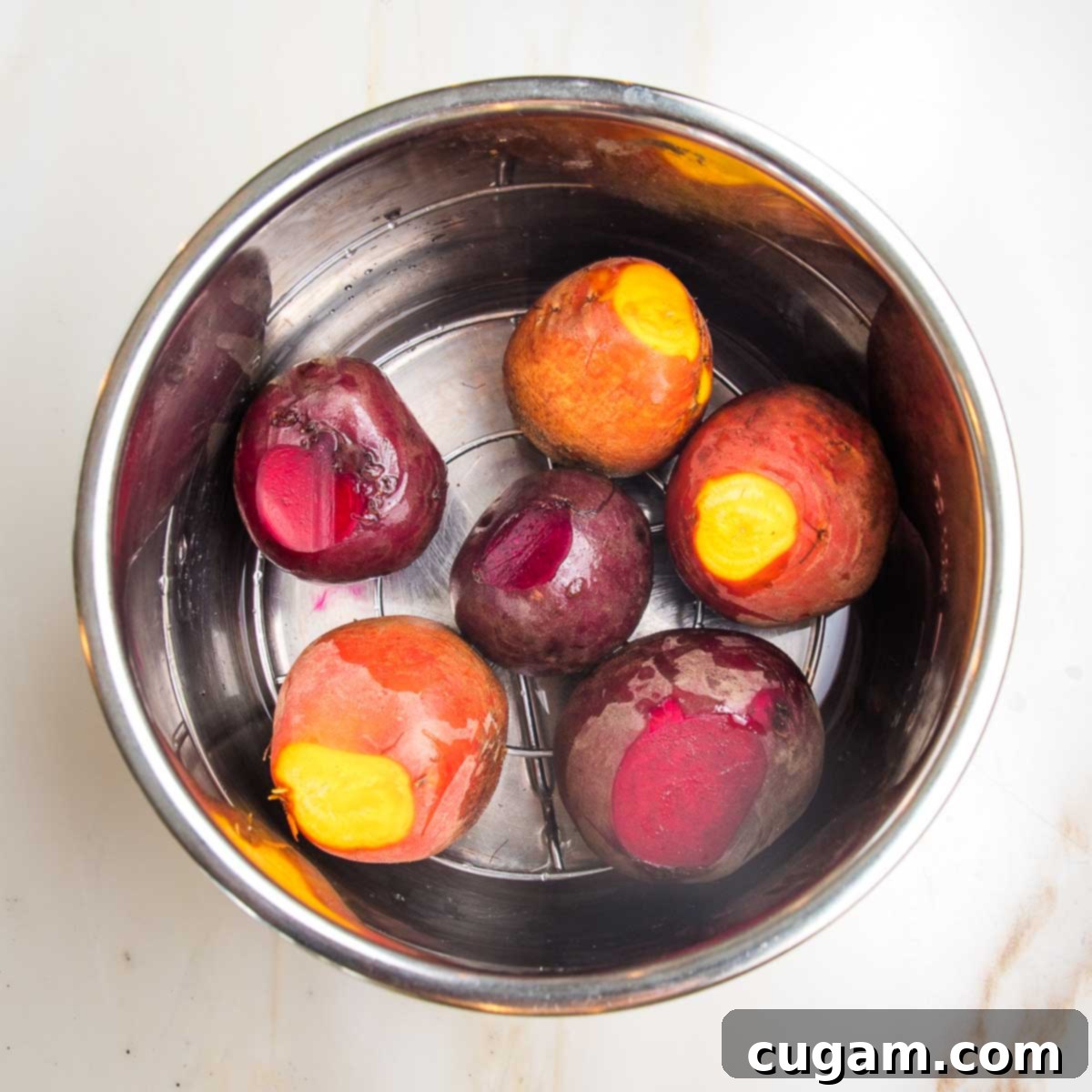
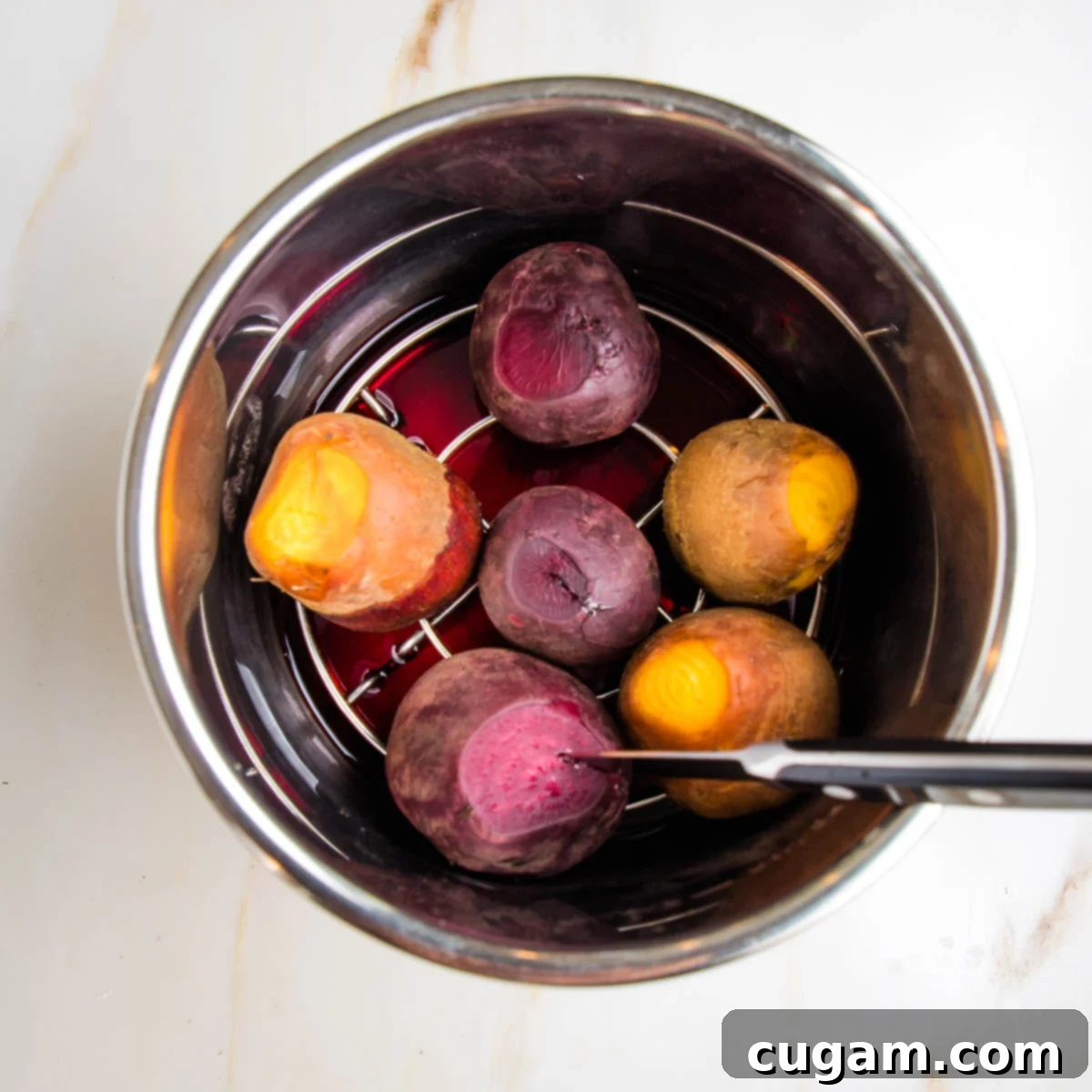
For Instant Pot Beets: For a quick and efficient cooking method, place your whole, trimmed beets directly onto the trivet rack inside your Instant Pot. Pour 1 cup of water into the bottom of the pot. Secure the lid, seal the valve, and cook medium-sized beets on high pressure for approximately 15 minutes. Once the cooking cycle is complete, use the quick release method to depressurize. The beets should be perfectly tender, allowing a paring knife to slip in with minimal resistance. For larger beets, you may need to add an additional 3-4 minutes, while extra-large beets could require up to 20 minutes on high pressure. Always ensure they are fork-tender.
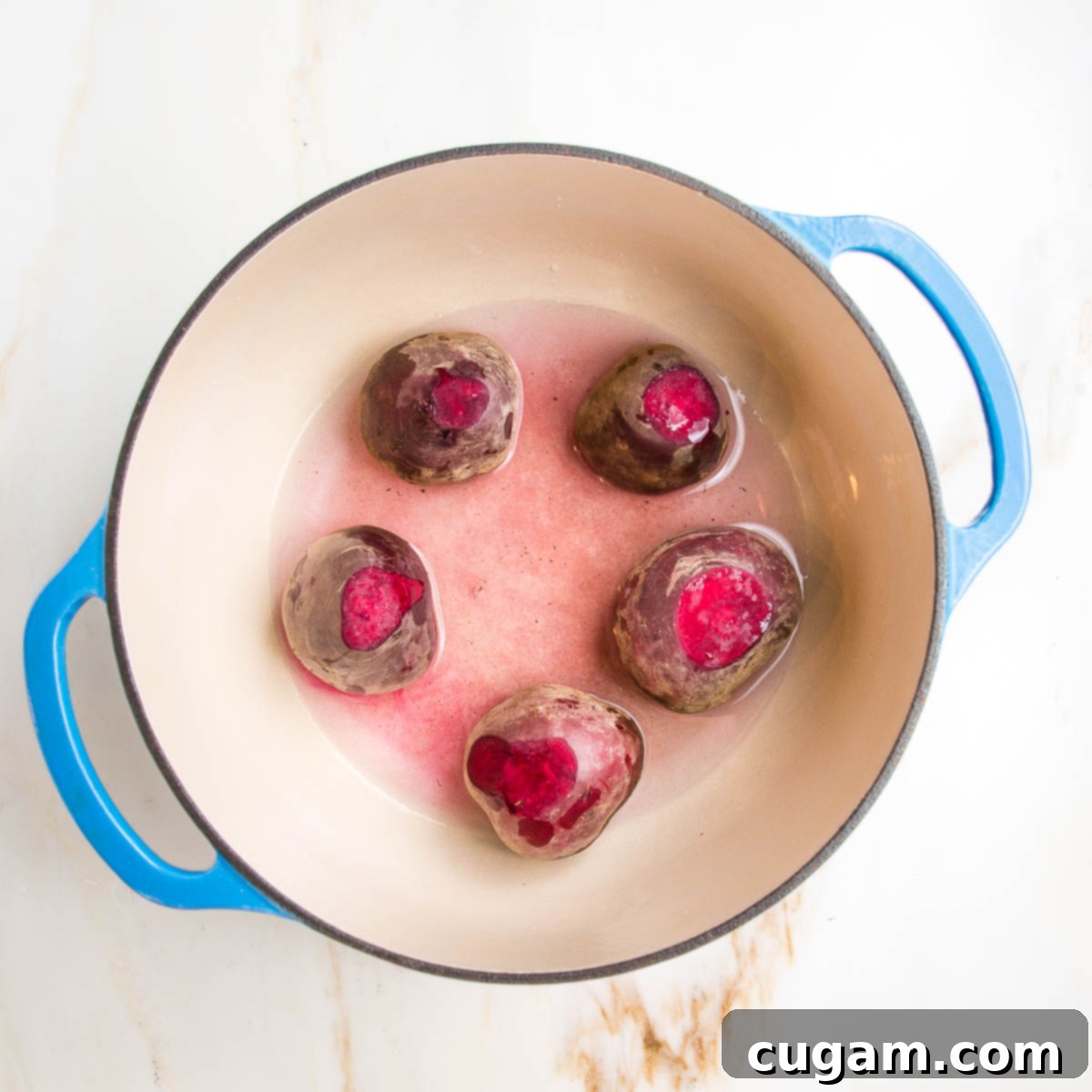
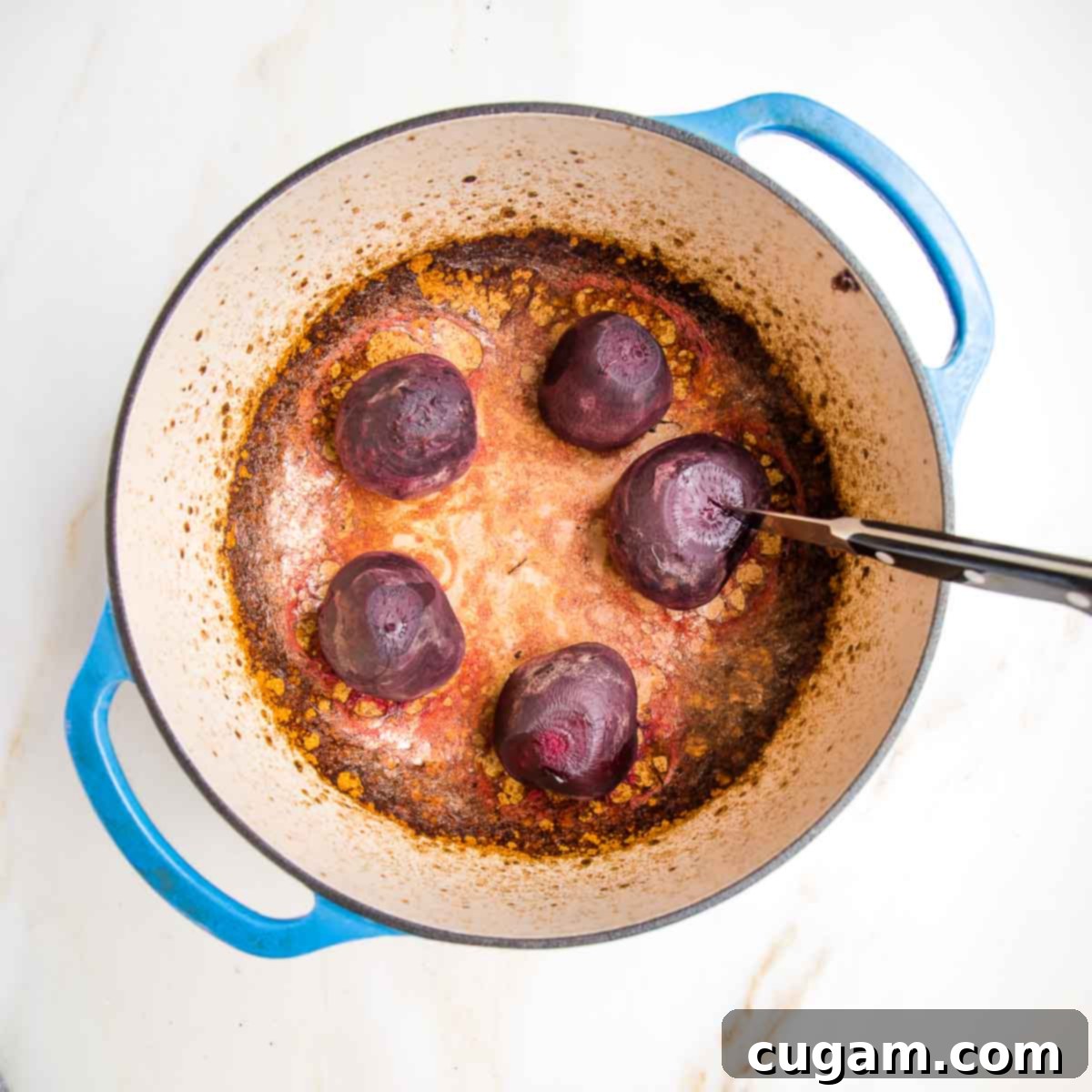
Dutch Oven Whole Roasted Beets: For a more traditional roasting method, place your trimmed whole beets on the bottom of a Dutch oven. Add about 1 inch of water to the pot, then cover tightly with the lid. The trapped steam ensures even cooking and tender results. Roast medium-sized beets in a preheated 425°F (220°C) oven for approximately 1 hour. Keep an eye on them towards the end, as cooking times can vary based on beet size and oven calibration. You can find more detailed guidance on cooking times below or in the full recipe card.
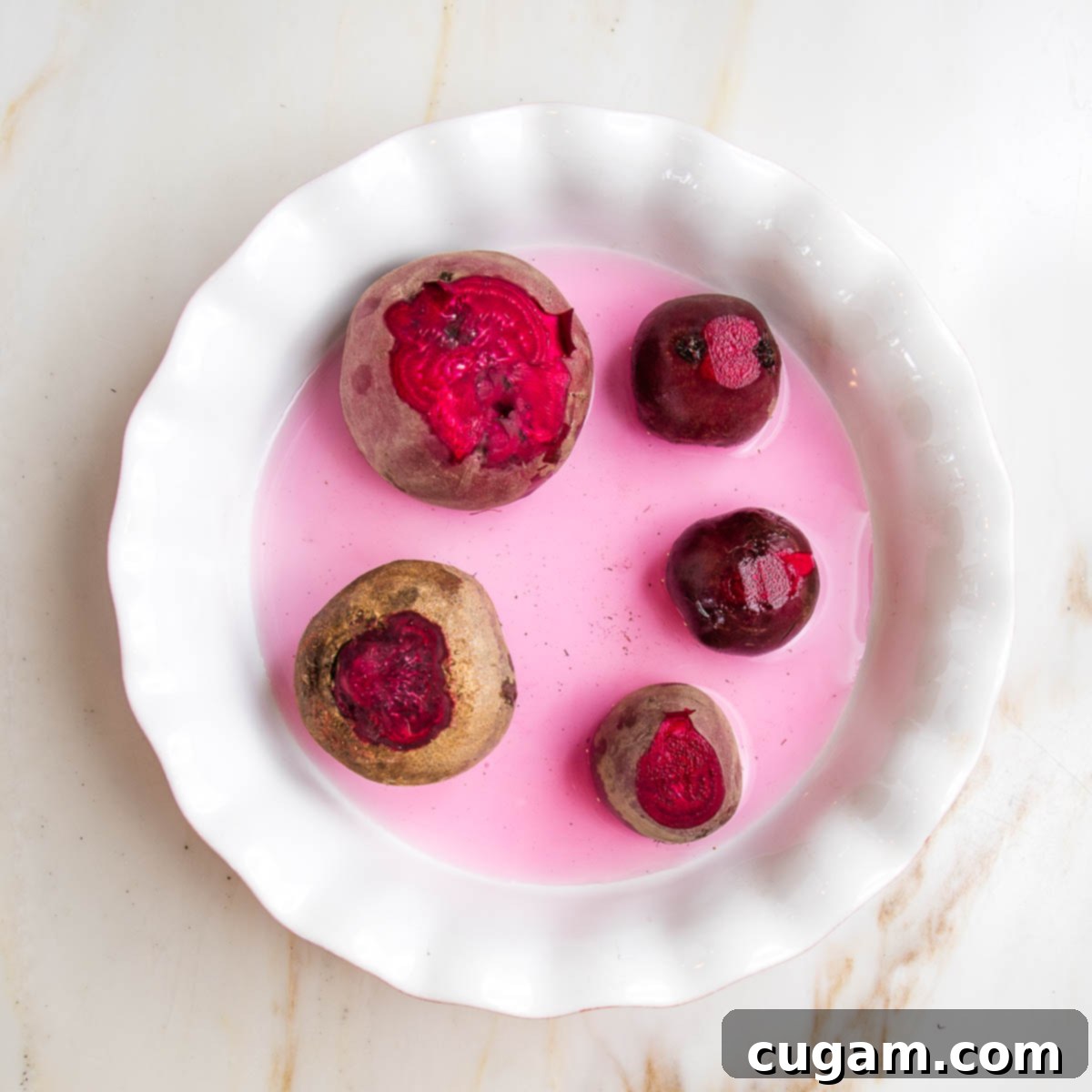
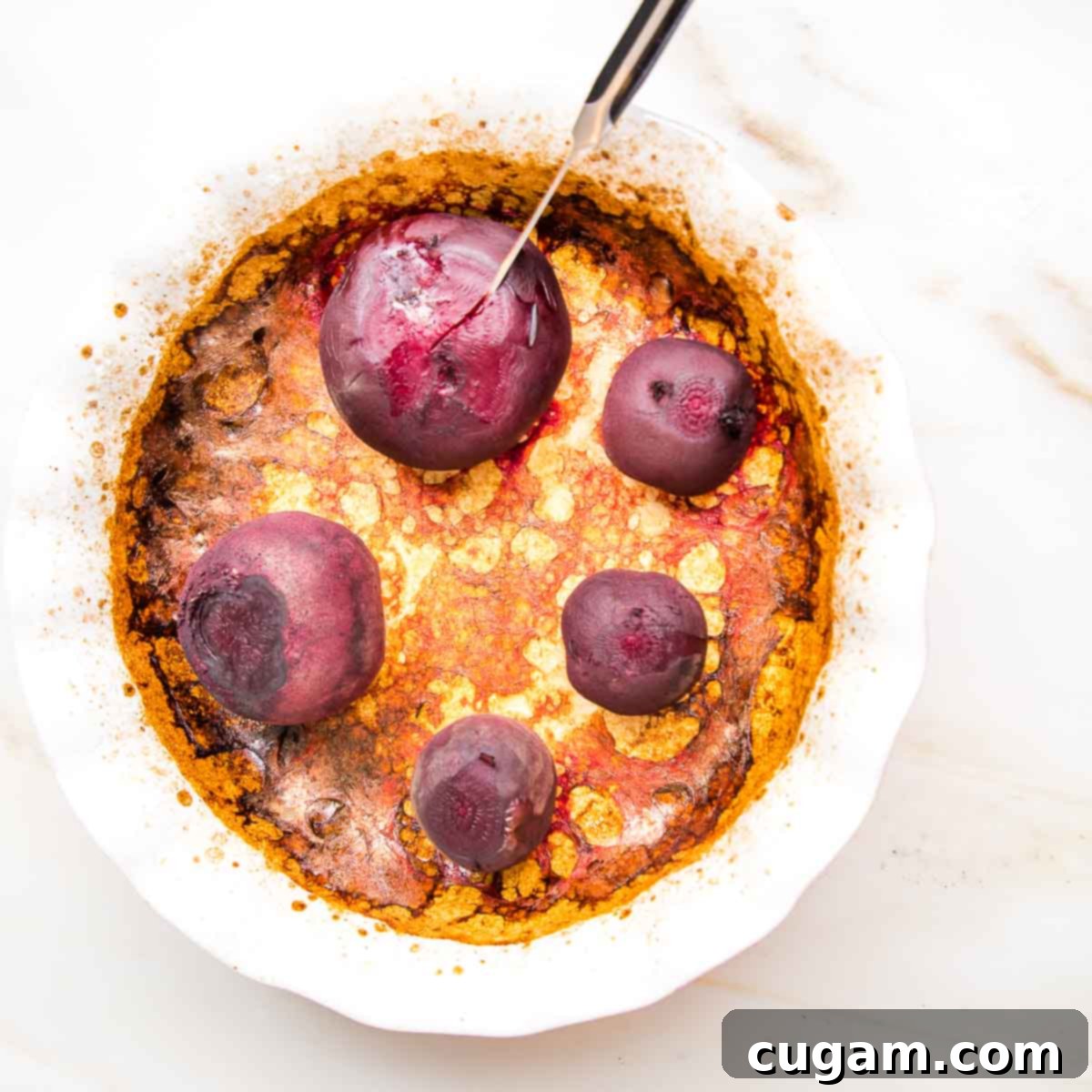
Whole Roasted Beets in a Baking Pan: This method is similar to using a Dutch oven but utilizes foil for sealing. Place your trimmed beets in a shallow baking dish, ensuring they are arranged in a single layer to promote even cooking. Add about 1 inch of water to the bottom of the dish. To enhance the steaming effect and provide a non-stick barrier, take a piece of unbleached parchment paper, wet it thoroughly, then crumble it and squeeze it dry. Unfold the wrinkled, slightly damp parchment and lay it directly over the beets. Finally, cover the entire baking dish tightly with aluminum foil to create a steamy environment. Place the covered dish in a preheated 425°F (220°C) oven for 1 hour for medium-sized beets. If your beets are larger, add an additional 15 minutes to the cooking time, checking for tenderness as described.
How Long to Cook Whole Beets for Optimal Tenderness
NOTE: Beets are perfectly cooked when they are tender enough to be easily pierced with the tines of a fork or a small paring knife. For a delicious beet salad, you want them tender, but still firm enough to hold their shape – avoid mushy beets! Always check for doneness at the recommended times below and adjust as needed, as beet sizes can vary significantly.
- Pressure Cooker Beets: For Instant Pot cooking, place trimmed beets on the trivet rack with one cup of water. Cook on high pressure for 15 minutes for medium-sized beets (approx. 2-3 inches in diameter). Adjust the cooking time by 3-4 minutes, either adding for larger beets (3-4 inches) or reducing for smaller ones (1-2 inches). Use the quick release function when done.
- Dutch Oven Roasted Beets or Beets Baked in a Baking Dish: Arrange beets in a single layer at the bottom of your dish and add about 2 inches of cool water. Seal tightly with the Dutch oven lid, or for a baking dish, use a damp piece of parchment paper followed by a tight seal of aluminum foil. Bake in a preheated 425°F (220°C) oven for 1 hour for medium-sized beets. Add an extra 10 minutes for large beets, and a full 20 additional minutes for extra-large beets (over 4 inches in diameter).
- Roasted Beets in Foil Packets: If opting for foil packets (with parchment protection), cut a piece of aluminum foil large enough to fully encase each beet. Place a piece of parchment paper onto the foil, then lay the trimmed whole beet on the parchment. Wrap each beet individually to create a sealed packet and place them on a rimmed baking sheet. This ensures the beets do not come into direct contact with the aluminum. Roast in a 400°F (200°C) preheated oven for 45 minutes if your beets are small. For medium-sized beets, add 10 minutes, and very large beets could take as long as 1 hour and 15 minutes to become perfectly tender.
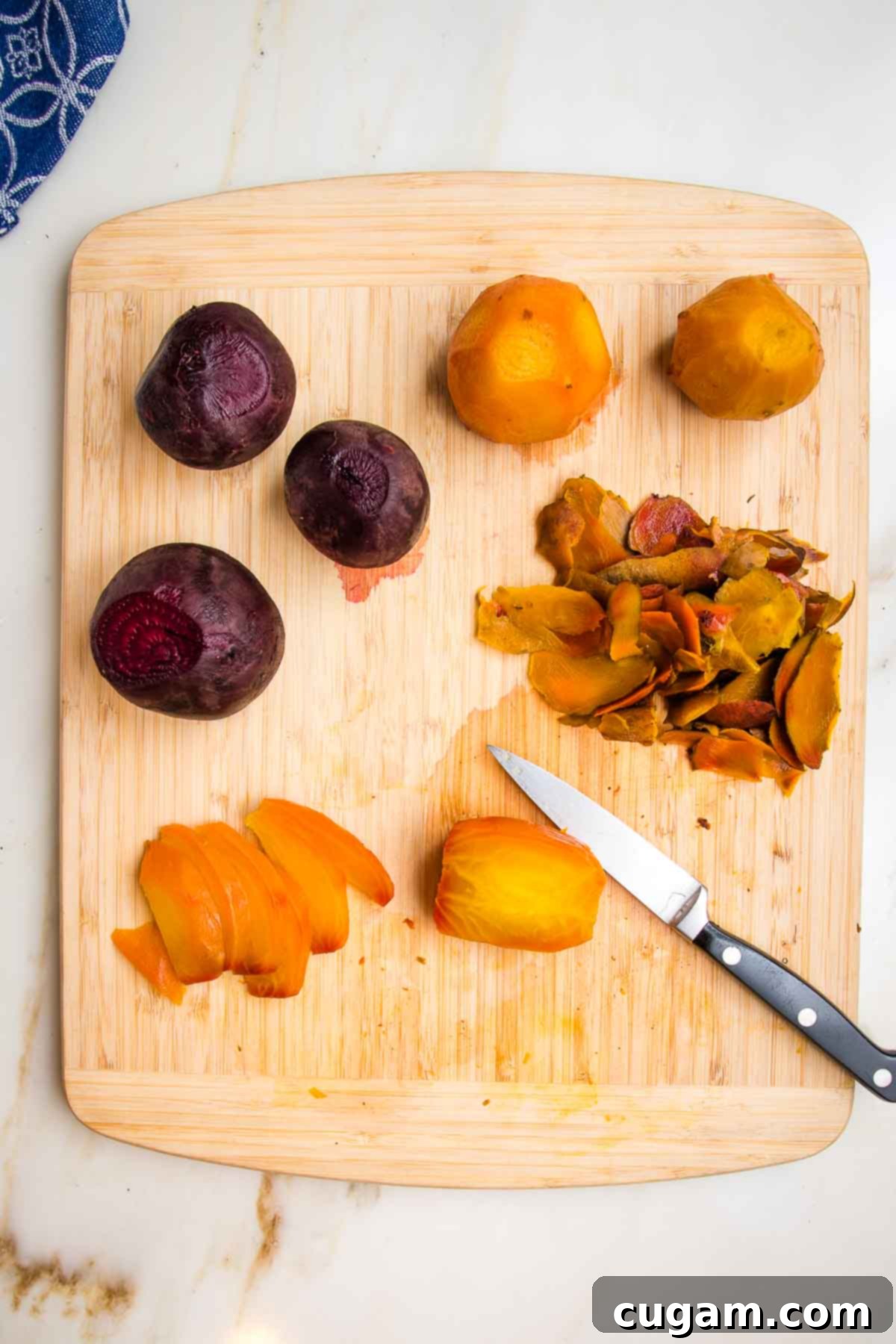
Once your beets are perfectly cooked, allow them to cool just enough so they are comfortable to handle. Transfer the cooked whole beets to a cutting board. One of the greatest advantages of roasting beets whole is how incredibly easy they are to peel! Simply use a paper towel or your gloved hands to rub the papery outer skin right off. It should come away with very little effort. Alternatively, you can use a small paring knife to gently remove any remaining skin, but often, the rubbing method is sufficient.
Next, carefully cut the peeled beets in half, then slice each half into uniform wedges or desired cubes. This creates bite-sized pieces that are ideal for a salad, ensuring each forkful is perfectly balanced. Maintain consistency in size for an appealing presentation.
Place the warm, roasted, and sliced beets into a clean mixing bowl. Generously drizzle them with the extra virgin olive oil, balsamic vinegar, and white vinegar. Sprinkle with a good pinch of coarse sea salt, freshly ground black pepper, and the vibrant chopped fresh parsley. Mix everything well to ensure all the beet wedges are thoroughly coated in the delicious vinaigrette and seasonings. The warmth of the beets will help them absorb the flavors beautifully. Finally, taste for seasoning and adjust as needed, adding a little more salt and pepper to achieve your desired flavor balance. Serve warm or at room temperature for the best experience.
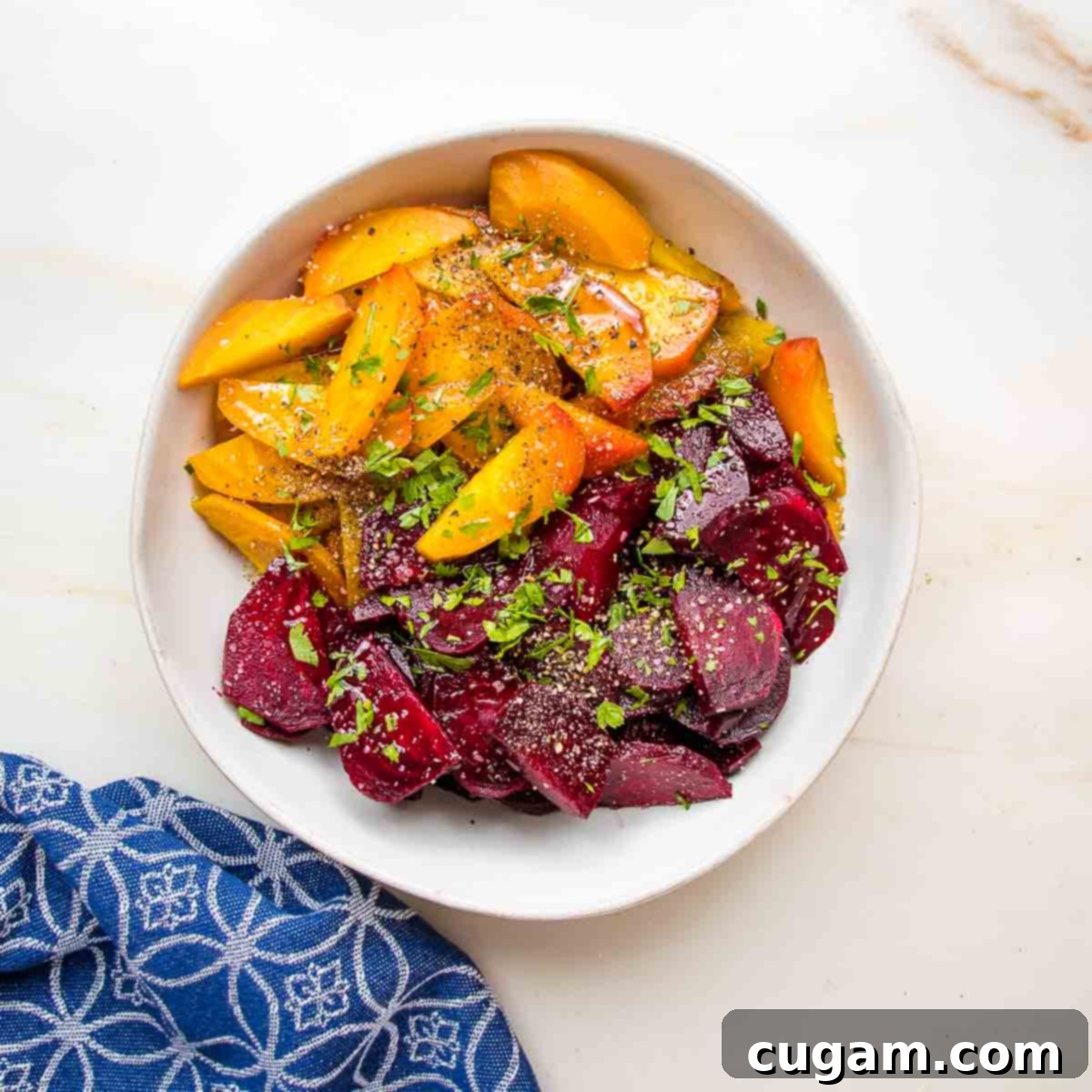
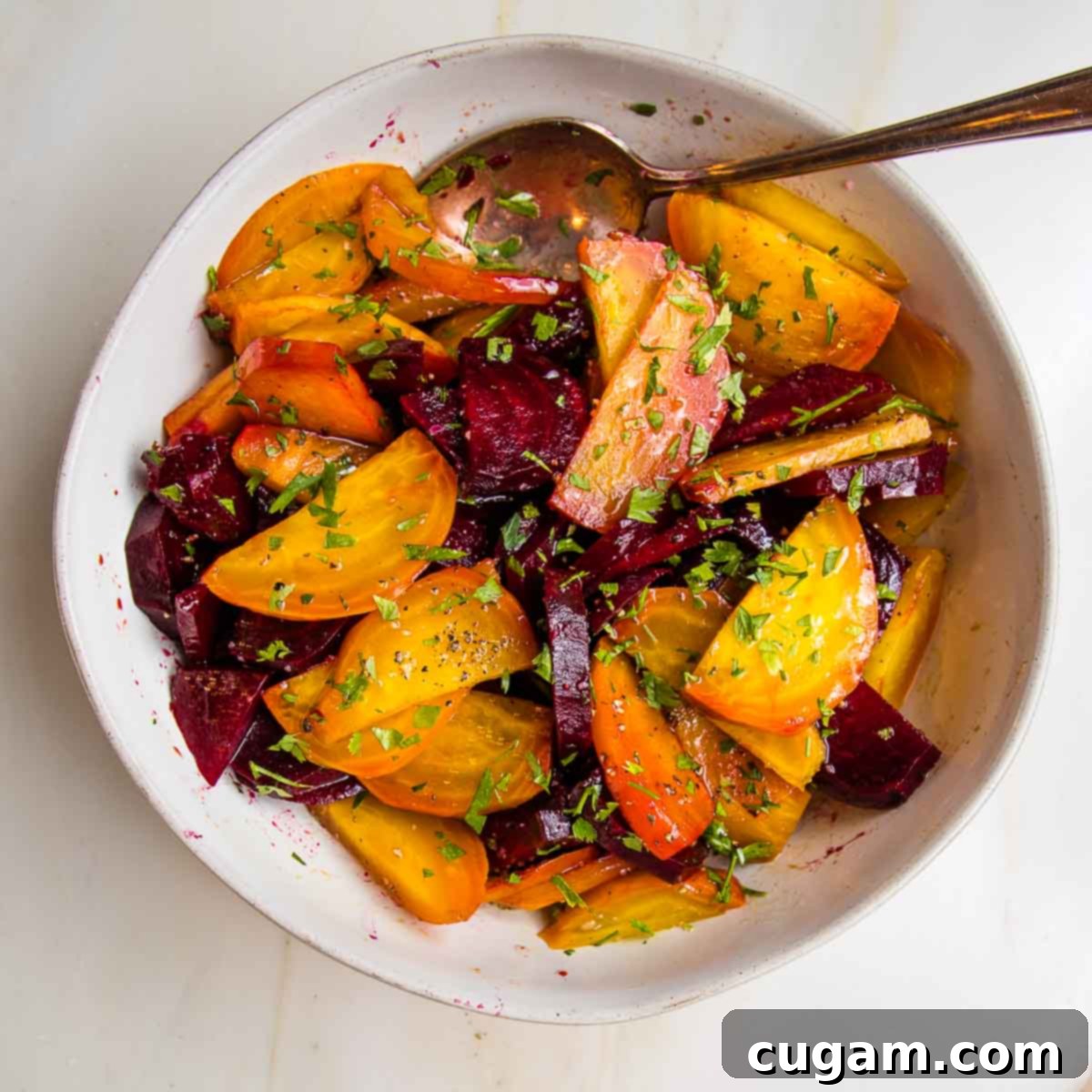
Serving Suggestions & Delightful Variations
While this roasted beet salad is fantastic on its own as a vibrant and healthy side dish, its versatility allows for many delicious pairings and variations, making it suitable for any occasion. Serve it warm alongside grilled chicken, flaky baked fish, or hearty plant-based proteins like lentils or chickpeas for a complete meal. For a refreshing and light lunch, pile it onto a bed of fresh, peppery arugula or tender spinach. The greens add a wonderful textural contrast and an extra layer of flavor that complements the sweet beets beautifully. If you’re not strictly adhering to a cheese-free diet, a sprinkle of crumbled goat cheese or tangy feta would be a classic and delightful addition to this salad, offering a creamy, salty counterpoint. However, the true beauty of this recipe lies in celebrating the pure, unadulterated flavors of the beets themselves. For added texture and a nutty richness, consider sprinkling a handful of toasted walnuts, pecans, or sunflower seeds over the top. A squeeze of fresh orange juice before serving can also add an unexpected burst of citrusy brightness, elevating the flavors even further.
Debra’s Pro Tips for Beet Perfection & Easy Cleanup
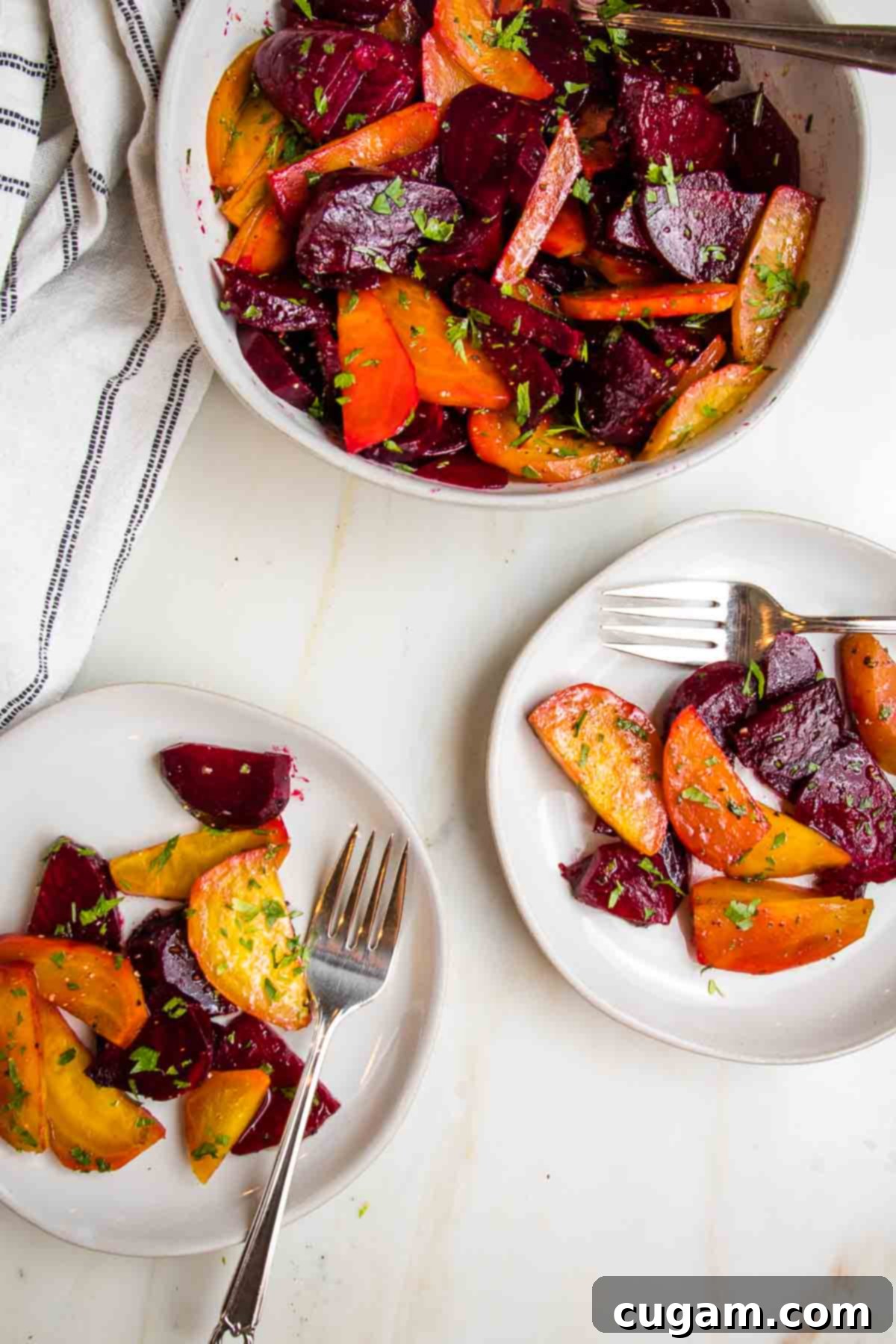
- Don’t Waste the Beet Greens! The leafy greens and slender stems attached to your beets are incredibly nutritious and delicious – they are practically a second vegetable! Don’t discard them. First, finely chop the stems and sauté them in a little olive oil with some crushed garlic and a sprinkle of sea salt until they begin to soften. Then, add the chopped greens, turn off the heat, and simply wilt them for a minute or two. They make a fantastic, healthy side dish, can be added to stir-fries, folded into scrambled eggs, or even incorporated into soups and stews for an extra nutrient boost.
- Color Contrast for Visual Appeal: For a truly stunning roasted beet salad that’s as appealing to the eyes as it is to the palate, use a combination of golden beets and red beets. The contrasting vibrant colors create a beautiful presentation that elevates the dish, making it perfect for entertaining or simply brightening up your everyday meal.
- Removing Beet Stains from Cutting Boards: Beet juice can leave stubborn, bright pink stains on wooden cutting boards. To effectively clean them, simply sprinkle the stained area generously with coarse kosher salt, then scrub it vigorously with half a lemon. The abrasive salt acts as a gentle scrubber while the acidic lemon juice works wonders to lift and bleach away the color. Rinse thoroughly afterward.
- Easy Messy Pan Cleanup: If your Dutch oven or baking pan looks anything like mine after roasting beets – with caramelized bits and stubborn stains – don’t despair! Cleanup is easier than you think. You can use a chain link scrubber with a little hot water, and the residue will come right off with minimal effort. Another effective method is to boil a bit of water with a sprinkle of baking soda in the pan; let it simmer for a few minutes, then use a sponge to easily wipe it clean.
- Make-Ahead Tip: Roasted beets can be prepared in advance to streamline your meal prep. Once roasted, peeled, and sliced, store them in an airtight container in the refrigerator for up to a week. Dress them with the vinaigrette just before serving for the freshest taste and most vibrant flavors. This makes them perfect for quick weeknight meals or for bringing to potlucks.
More Delicious Root Vegetable Recipes to Explore
If you’ve enjoyed the earthy sweetness and versatility of this beet salad, you’ll love these other root vegetable-centric dishes. Root vegetables offer incredible depth of flavor, satisfying textures, and a wealth of nutrients, making them perfect for healthy and hearty meals throughout the year. Expand your culinary horizons with these delicious recipes:
- Lentil Salad with Roasted Vegetables
- Whole Roasted Carrots with Tahini Sauce
- Balsamic Roasted Root Vegetables
- Easy Tzimmes Recipe with Carrots and Sweet Potatoes
Did you know commenting and rating recipes is one of the best ways to support your favorite food bloggers? If you made this recipe, please consider a five-star rating below and leave a comment. Also, please share your photos on Instagram by tagging me @dkhealthcoach and using the hashtag #debraklein! Your feedback and shares are incredibly valuable and help our community grow. Thank you for your support!
📖 Recipe
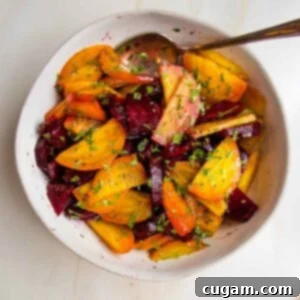
Whole Roasted Beets with Vinaigrette
Rate this Recipe
Pin Recipe
Equipment
-
Instant pot
-
Dutch oven
-
Extra Large Bamboo Cutting Board
-
Global 3″ Paring Knife
Ingredients
Ingredients:
- 1 ½ lbs. beets trimmed, red or golden, about 4-5 medium beets
- 2 Tablespoons extra virgin olive oil
- 2 teaspoons balsamic vinegar
- 1 teaspoon white vinegar
- ¼ teaspoon coarse sea salt or to taste
- ¼ teaspoon freshly ground black pepper or to taste
- 1 Tablespoon fresh parsley minced, for garnish and flavor
Instructions
-
If oven roasting, preheat oven to 425°F (220°C).
-
Thoroughly wash and trim the beet greens and root ends from your beets. Wear gloves to prevent staining.
Instant Pot Method
-
Insert the trivet rack into your Instant Pot. Place the trimmed whole beets onto the rack. Add 1 cup of water to the bottom of the pot. Secure the lid, seal the valve, and set on high pressure for 20 minutes for medium beets. For smaller beets, set to 17 minutes; for larger beets, approximately 25 minutes. Use quick release when done.
Oven Roasting Method (Dutch Oven or Baking Dish)
-
Place trimmed beets in a Dutch oven or a ceramic/glass baking dish. Add ½” water to the bottom of the dish. Cover tightly with a lid (for Dutch oven) or with a damp piece of parchment paper followed by tightly sealed aluminum foil (for baking dish). Bake medium-sized beets for 1 hour at 425°F (220°C). For larger beets, increase baking time to 1 hour and 20 minutes.
-
Beets are fully cooked when they are easily pierced with a fork or paring knife and are tender, but not mushy.
-
Once beets are cool enough to handle, gently rub the skins off using a paper towel. For stubborn spots, use a small knife.
-
Cut the peeled beets in half, then into wedges or cubes. Place them in a bowl. While still warm, drizzle with extra virgin olive oil, balsamic vinegar, and white vinegar. Sprinkle with sea salt, black pepper, and minced fresh parsley. Mix well to combine. Taste and adjust seasoning as needed, adding more salt and pepper to your preference. Serve warm or at room temperature.
Notes
- SERVE: This versatile salad can be served cold or at room temperature. It’s excellent on its own, atop a bed of fresh salad greens, or even incorporated into homemade hummus for a unique twist.
- PREP AHEAD: To save time, roast your beets whole in advance. Once cooled, store them unpeeled in an airtight container in the fridge for up to one week. Peel and prepare the salad just before serving.
- STORE: Leftover roasted beetroot salad can be stored in an airtight container in the refrigerator for up to a week. For optimal freshness, sprinkle with additional fresh chopped parsley before serving leftovers.
- FREEZE: Whole roasted beets can be frozen for longer storage, up to 3 months. After roasting and cooling, wrap them individually in unbleached parchment paper, then in aluminum foil or place them in freezer-safe bags. Thaw in the refrigerator before peeling and using.
Nutrition
Note
The nutrition calculations were done using online tools. To obtain the most accurate representation of the nutritional information in any given recipe, you should calculate the nutritional information with the actual ingredients you used. You are ultimately responsible for ensuring that any nutritional information is accurate, complete and useful.
